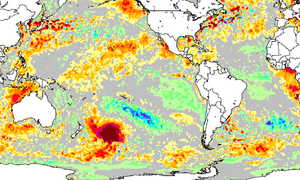Note: This is from foreign media.
Scientists are "puzzled" once again and the scientist at Victoria University who I think will give any explanation to justify his "easy-does-it" approach to climate change thinks it is due to "more sun"and "less wind".
“It’s just a patch of water that’s had a lot of sunny skies and not much wind”.
These people take a description and call it a "cause"
No wind???
Our part of the world is still one of the windiest on the planet.
***
***
I
have been reporting on a hot blob in the Tasman Sea for the last 3
years. During that period it never went away and only dissipated over
the last year.
I
was observing and reporting on this LONG BEFORE the authorities who
only mentioned it when it was too obvious to be ignored while always
reporting in a way that understated the phenomenon (I am talking of
NZ's NIWA, the equivalent of NOAA.
Lots of sun?
Hot
blob: vast patch of warm
water off New Zealand coast
puzzles
scientists
Area
of water in the Pacific Ocean off NZ is 6C hotter than normal,
possibly due to a lack of wind in the region

27
December, 2019
A
spike in water temperature of up to 6C above average across a massive
patch of ocean east of New Zealand is likely to have been caused by
an “anti-cyclone” weather system, a leading scientist says.
Appearing
on heat maps as a deep red blob, the patch spans at least a million
square kilometres – an area nearly 1.5 times the size of Texas, or
four times larger than New Zealand – in the Pacific Ocean.
James
Renwick, the head of geography, environment and earth sciences at
Victoria University in Wellington, said the scale of the temperature
spike near the sparsely populated Chatham Islands archipelago was
remarkable, and had been building for weeks.
“It’s
the biggest patch of above average warming on the planet right now.
Normally the temperatures there are about 15C, at the moment they are
about 20C,” he said.
Renwick
said the blob could be linked to rising atmospheric greenhouse gas
emissions, as a result of climate change, but he expected it was
overwhelmingly due to natural variability – a strong high pressure
system and a lack of wind.
“It’s
not uncommon to see patches of warmer water off New Zealand but this
magnitude of four, five, up to six degrees is pretty unusual,”
Renwick said.
“It’s
probably a very thin layer of ocean that has warmed up and there
hasn’t been any wind to cool it for several weeks.”
Anti-cyclones
form when a mass of air cools, contracts and becomes more dense,
increasing the weight of the atmosphere and the surface air pressure.
Renwick
said a surge in ocean heat over a short period could be difficult for
local marine life if it penetrated far beyond the surface. Ocean
temperatures are less prone to sharp changes than those on land due
to the amount of energy required to warm an area of water.
He
said scientists would study the spike in coming weeks to gain more
insight into its cause and local impact. It followed a marine
heatwave two summers ago that propelled New Zealand’s hottest
summer on record, more than 3C above average, and led to tropical
fish from Australia being found along the country’s coast.
(Ed.This was NOT a one-off blob that came and went as described here but was here for at least 2 years and has only dissipated in the last few months)
Across
the globe, the World Meteorological Organisation says the last decade
has almost certainly been the hottest on record for land and oceans.
Seas have also grown more acidic as they have absorbed carbon dioxide
from the atmosphere.
Temperatures
for the years 2010 to 2019 were about 1.1C above the average for the
pre-industrial period. The preliminary findings of the WMO’s annual
state of the global climate report released earlier this month found
this year was likely to be the second or third warmest since records
began.
From NZ media - this IN FULL from Pravda NZ Inc (AKA RNZ)
Marine
heatwave pushes temperatures 5C above normal
RNZ,
28
December, 2019
A
marine heatwave measuring almost one million square kilometres has
been detected off the east coast of New Zealand.
The
heatwave has pushed the ocean temperature up by about 5C above the
normal temperature of 15C.
The
large blob was identified by thermal imaging from the US National
Oceanic and Atmospheric Administration.
Victoria
University Professor of Physical Geography James Renwick said the
heatwave was likely to be caused by warm northerly winds and extended
periods of sunshine.
Dr
Renwick said, while heatwaves were not unusual, they were happening
more often due to the global warming.
He
also said marine life was likely to be affected.
Last
summer, a marine heatwave around New Zealand waters led to hot,
stuffy air temperatures across much of the country, and scientists
observed sub-tropical fish swimming far further south.
This
time round, it doesn't appear the ocean heat will have much impact on
land temperatures, as the currents are moving towards South America.
From not quite a year ago. The only cause of concern seems to be about fish life because it was a "one-off" affair as it was the year before that, and the year before that as it is this year.
The
Tasman Sea warmed on average by 3.7C above normal to reach 20.6C,
with fish normally found in the tropics straying further south than
they are supposed to.
University
of Otago physical oceanographer Dr Robert Smith said while this may
be good for recreational fishers, it pointed to the disruption of
ecosystems that could be devastating to some species.








No comments:
Post a Comment
Note: only a member of this blog may post a comment.